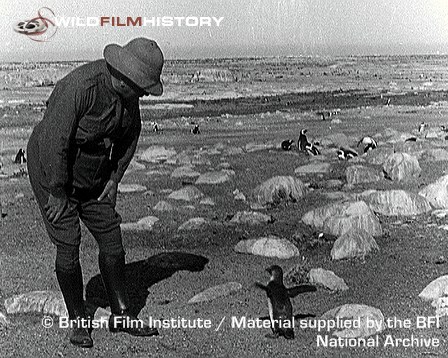WildFilmHistory Films
| Photography | |
| Narrator, Photography, Director | |
| Presenter, Producer, Photographer | |
| Copyright Holder | |
| Photography |

One of the earliest pioneers of wildlife photography and filmmaking, Cherry Kearton developed a deep love of the natural world during his upbringing on the Yorkshire moors. A chance meeting between his brother, Richard, and an associate of a London publishing house led to their employment, and consequently the release their first natural history book, British Bird Nests, in 1895. The first of its kind to contain stills from nature rather than illustrations, the book was a landmark in natural history documentation and confirmed Cherry's talent for wildlife photography.
The brothers developed a number of innovative techniques to obtain their revealing shots, using ladders, special tripods, and camouflage tactics that included false trees and hides made from dead animals. With the advent of moving pictures, Cherry devoted himself to filmmaking, while Richard continued researching and writing. Starting with essentially 'moving stills' of birds over time, and with the development of new technology, Cherry began making feature films for U.K. and U.S. cinema.
On his first African expedition he joined up with the former president of the U.S., Theodore Roosevelt, filming the official documentation of his extensive research trip. 1909 saw the release of With Roosevelt in Africa and Kearton went on to produce numerous titles including A Journey To The Inner Africa (1911), Life in the Sudan (1925), and Tembi (1929), the hugely popular account of his trip through Central Africa with his wife Ade.
After his initial success, Cherry began to narrate and star in his own movies, rapidly becoming an international star of the silver screen. His compilation film, With Cherry Kearton in the Jungle (1926) was greatly received by audiences and received the honour of Royal Command. In 1930 his famous film, Dassan: An Adventure in Search of Laughter Featuring Nature's Greatest Little Comedians was released, profiling the charismatic penguins found off Africa's southern coast.
An early conservationist, Cherry voiced concern over a number of environmental issues and unlike many wildlife filmmakers of the time, did not enjoy hunting for sport. In the course of his life, Cherry travelled over five continents, sharing his passion for the natural world through a variety of books, films and television programmes.
He died in 1940, collapsing on the street outside Broadcasting House, London where moments before he had been taking part in a feature about animals for a children's programme. A dedicated naturalist, Cherry's groundbreaking work in natural history is recognised worldwide, and in 1967 The Royal Geographical Society launched the Cherry Kearton Medal and Award, helping other young wildlife enthusiasts on their way.
| Photography | |
| Narrator, Photography, Director | |
| Presenter, Producer, Photographer | |
| Copyright Holder | |
| Photography |